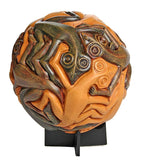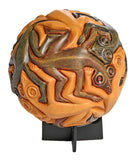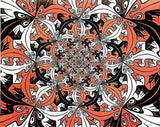Lizards Geckos Tessellation Pattern Orb Paperweight by Escher 3H
PN# ESC06From Escher's series of tessellations, this artwork illustrates gecko lizards moving, identified by different colors, interlocked in a unique configuration. Taken from a tessellation drawing, it has been adapted into a round sculptural ball. The ball makes a handsome desktop paperweight adornment.
By the way...this feels really cool when you hold it in your hand. Kind of like a baseball. It has a very nice weight! -- Curator's note.
- Part of the highly collectible Parastone Mouseion 3D Museum Collection. PN ESC06.
- Measures: 3 in H x 3 in W x 3 in D sphere. Weight 1.1 lbs.
- Made from resin with hand-painted colorings.
- Comes with a removable black stand as pictured and color description card.
Escher initially pursued a career in architecture, but his passion for graphic arts soon changed his mind. He was taught the principles of graphic art by S. Jessurun De Mesquit in the Dutch town of Haarlem. He then started traveling, somewhat restlessly, throughout Southern Europe where he made sketches and studies the landscape.











